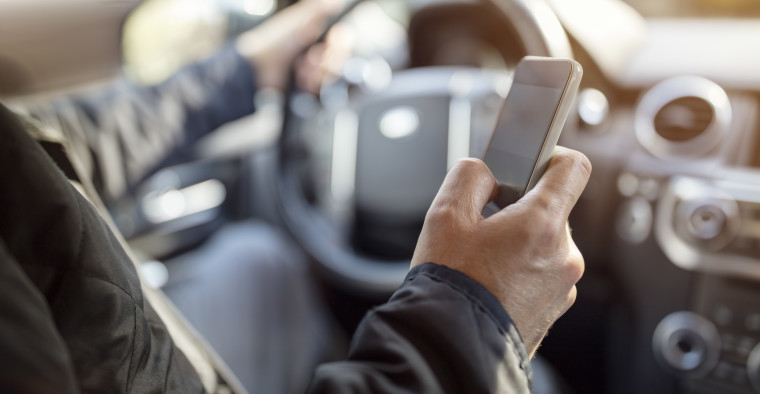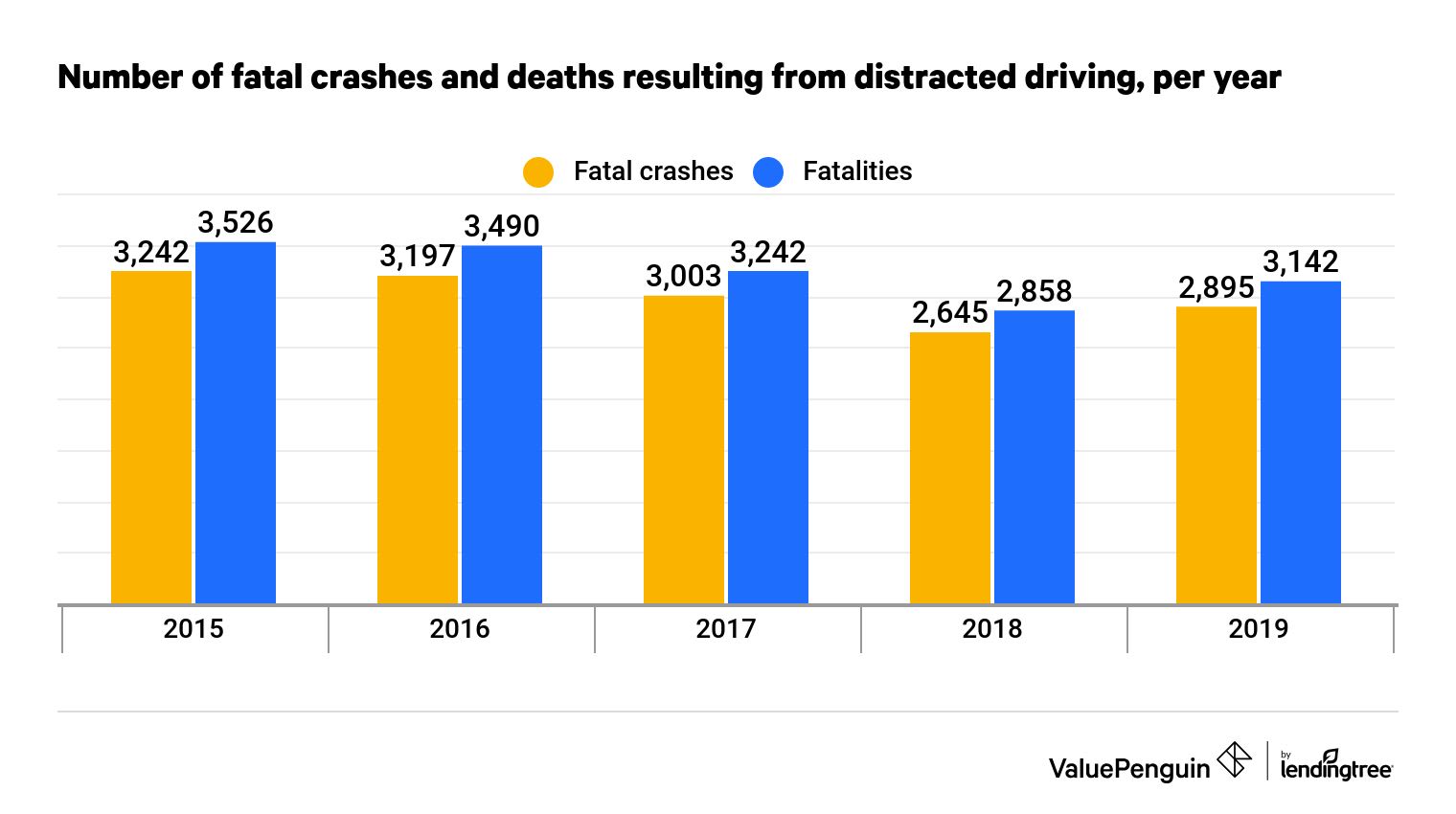Auto Insurance
New Mexico, Kentucky and Kansas Are the Worst States for Distracted Driving, Even as Crashes, Deaths Across U.S. Trend Downward

It's fairly common for more than one person to be killed in a distracted driving crash that turns fatal. Distracted driving resulted in 16,258 deaths from 14,982 fatal crashes from 2015 to 2019, according to an analysis of the most recent data from the National Highway Traffic Safety Administration (NHTSA). That means 109 people died in every 100 fatal distracted driving crashes.
On average, distracted driving caused 10.2 fatalities for every 10 billion miles that Americans traveled — and they traveled nearly 16 trillion miles during the years on which this study is focused. New Mexico saw a distracted driving death rate that was about five times greater than the U.S. average from 2015 to 2019. Although New Mexico doesn't have a primary ban on using phones while driving, five of the 10 states that had the most fatal crashes and fatalities from 2015 and 2019 do, including Washington, New Jersey and Virginia.
It might seem like a decrease in the number of miles Americans traveled in 2020 would result in fewer fatal crashes and fatalities caused by distracted driving. But while ValuePenguin projects the pandemic resulted in fewer crashes, our researchers estimate that fatalities rose across the U.S. in 2020, though this number varied by state.
Key findings
- Distracted driving accidents that turn deadly sometimes kill more than one person. According to the most recent data from the NHTSA, there were 109 fatalities from distracted driving for every 100 fatal crashes from 2015 to 2019.
- There were 16,258 distracted driving fatalities resulting from 14,982 crashes from 2015 to 2019, with an 11% decrease in the total number of people killed and the total number of fatal crashes during this time frame.
- On average, there were 10.2 fatalities per 10 billion miles traveled across the U.S.. In New Mexico, there were five times more distracted driving fatalities than the national average — making it the worst state for distracted driving.
- Half of the 10 states with the highest numbers of fatal crashes relative to miles traveled have the most stringent laws against distracted driving, including Hawaii, Washington, New Jersey, Idaho and Virginia.
- Based on 2020 data from the Federal Highway Administration (FHWA), ValuePenguin projects that the decrease in the number of miles driven by Americans during the pandemic will have resulted in 242 fewer fatal crashes and 23 more fatalities from distracted driving, though estimates vary by state.
Though there were 16,258 deaths caused by distracted driving from 2015 to 2019, there was an overall decrease in fatal car crashes that were the effect of distracted driving
In the U.S., there was an 11% decrease in the number of fatal car crashes and people killed from distracted driving accidents when comparing 2015 to 2019. The number of deaths fell overall, from 3,526 in 2015 to 3,142 in 2019, despite the number of deaths rising from 2018 to 2019. The number of fatal accidents fell at the same rate, though there were 250 more fatal crashes in 2019 than the year before — the only time when either fatalities or crashes rose compared to the previous year in the period examined.

From 2015 to 2019, Americans traveled nearly 16 trillion miles by car. This means that there were 9.4 fatal distracted driving crashes per 10 billion miles driven nationally, or 10.2 fatalities over the same distance traveled. A single crash, then, sometimes resulted in more than one death, as there were 109 deaths per 100 fatal crashes caused by distracted driving.
The number of distracted driving deaths per 10 billion miles was higher in 19 states than the national average.
New Mexico was the worst state for distracted driving with the highest number of fatal crashes and deaths per 10 billion miles. It also had the most people killed per accident among states where distracted driving caused at least 100 fatal crashes.
The state experienced nearly five times more fatal crashes caused by distracted driving than the national average — 46.7 fatal crashes per 10 billion miles. At the same time, the number of deaths per 10 billion miles was 53.9 — five times greater than the national average. Finally, among states where distracted driving caused at least 100 fatal crashes, New Mexico saw the highest per-crash death rate, as 115 people were killed for every 100 crashes.
Rank | State | Fatalities per 10 billion miles |
|---|---|---|
| 1 | New Mexico | 53.9 |
| 2 | Kentucky | 33.0 |
| 3 | Kansas | 28.8 |
| 4 | Louisiana | 27.1 |
| 5 | Hawaii | 22.4 |
| 6 | Washington | 21.4 |
| 7 | Idaho | 20.0 |
| 8 | New Jersey | 18.9 |
| 9 | Virginia | 14.5 |
| 10 | Texas | 14.4 |
| 11 | Montana | 12.2 |
| 12 | Wyoming | 12.0 |
Data shows that anti-handheld laws are largely successful at combating distracted driving
States across the country have implemented anti-cellphone usage laws to combat what the NHTSA identifies as one of the most common causes of distracted driving — texting and talking while driving. Twenty-six states have implemented a complete handheld device ban, while others prohibit usage in certain zones or by certain people — such as bus drivers (Kentucky) or newly licensed residents (Alabama). These laws have been largely effective at lowering the deaths that are caused by distracted drivers.
Across the states that have enacted a primary ban on drivers using all handheld devices while operating a car, the average fatal crash rate of 8.2 per 10 billion miles traveled was lower than the rate in states without such a ban (12 per 10 billion miles). Similarly, fatalities were down in states with restrictions on devices: 8.8, compared with 13.2 deaths per 10 billion miles.
At the same time, half of the 10 states with the highest rates of deaths per vehicle miles traveled were states with primary bans on handheld devices. These states were:
- Hawaii
- Washington
- Idaho
- New Jersey
- Virginia
At the other end of the spectrum, the effects of anti-cellphone laws are clear: Of the 10 states with the lowest numbers of distracted driving deaths per miles traveled, just one doesn’t have primary anti-handheld legislation for all drivers: Mississippi. This state was the safest for distracted driving in terms of both fatal crashes and deaths.
The pandemic likely increased the number of people killed by distracted drivers, but lessened the number of fatal crashes — though results vary by state
The coronavirus pandemic upended everyday life in many ways during 2020. One effect of the pandemic was that drivers traveled far less than they did in normal years. ValuePenguin compiled monthly reports published by the FHWA and found that Americans traveled 366 billion miles less in 2020 than the average of the previous five years.
While the NHTSA hasn’t yet updated its distracted driving statistics for 2020, ValuePenguin used the information made available by the FHWA to estimate a stark drop-off in distracted driving crashes during that year. Judging by the average crash rate per 10 billion miles and the number of miles traveled in 2020, ValuePenguin projects there were 242 fewer fatal crashes due to distracted driving in 2020 than the year before. At the same time, however, we project a slight increase in the number of fatalities, with an uptick of 23 compared to 2019.
Our model shows that fatal crashes decreased the most in Illinois, where there were likely 91 fewer accidents in 2020 that were caused by distracted driving than there were in 2019. Alternatively, Kentucky and Wisconsin saw the largest increase — 28 crashes. Michigan saw the steepest decline in fatalities, while Virginia experienced the highest jump at 49.
State | Change from 2019 - fatalities | Change from 2019 - fatal crashes |
|---|---|---|
| Alabama | -6 | -3 |
| Alaska | 0 | 0 |
| Arizona | 2 | -45 |
| Arkansas | 3 | 1 |
| California | -4 | -7 |
| Colorado | -2 | 15 |
| Connecticut | 1 | -3 |
| Delaware | -2 | 2 |
| District of Columbia | -3 | 1 |
| Florida | -18 | -42 |
| Georgia | -2 | 14 |
| Hawaii | -8 | -8 |
How drivers can prepare for an encounter with a distracted driver
The easiest way to prepare to share the road with distracted drivers is to purchase uninsured motorist coverage.
The good news for most drivers is that even the minimum car insurance that licensed car owners are required to carry offers adequate protection against accidents caused by distracted drivers. In most cases following an accident, the victim files a claim with the at-fault driver's insurance company for damages. However, matters are more complicated when the at-fault driver doesn't have insurance.
If a driver is hit by another person who doesn't have car insurance, the driver who was hit could use their collision coverage to pay for non-medical expenses. Alternatively, the person who was hit could file a lawsuit against the uninsured driver for damages.
It's easier and cheaper to carry uninsured motorist insurance. It is often, but not universally, required for drivers to carry and pays for damages caused by an underinsured or uninsured driver. Adding this coverage is generally much cheaper than the cost of regular car insurance. It's also more affordable than the price hike that's likely to occur after a collision claim.
Methodology
For this study, ValuePenguin collected crash and fatality figures from 2015 to 2019 from the National Highway Traffic Safety Administration (NHTSA) Fatality and Injury Reporting System Tool (FIRST).
The NHTSA defines "distracted driving" as "any activity that diverts attention from driving, including talking or texting on your phone, eating and drinking, talking to people in your vehicle, fiddling with the stereo, entertainment or navigation system — anything that takes your attention away from the task of safe driving."
We displayed our analysis for FIRST's data as crashes or fatalities per 10 billion miles traveled. ValuePenguin used this rate to predict the number of fatal crashes and deaths based on the total miles traveled in 2020.
Data on vehicle miles was obtained from the U.S. Department of Transportation (DOT) Federal Highway Administration (FHWA). The distracted driving fatalities rate represents the average annual recorded deaths attributed to cellphone-related distracted driving accidents per 10 billion vehicle miles driven in the area in question.
Finally, information about distracted driving regulations was gathered from the Governors Highway Safety Association (GHSA).
